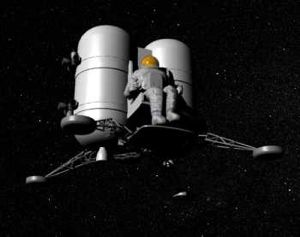Rocket Chair (original) (raw)

Home - Search - Browse - Alphabetic Index: 0- 1- 2- 3- 4- 5- 6- 7- 8- 9
A- B- C- D- E- F- G- H- I- J- K- L- M- N- O- P- Q- R- S- T- U- V- W- X- Y- Z
Rocket Chair
American manned lunar lander. Study 2005. In 2005 SpaceDev resurrected the 1960 NASA Langley individual crew lunar lander concept.
AKA: Open Cockpit Lunar Landers. Status: Study 2005.
On 21 November 2005 SpaceDev announced the results of its International Lunar Observatories Human Servicing Mission study, conducted for the Lunar Enterprise Corporation. The study concluded that safe, lower cost lunar missions could be completed by the private sector using existing technology or innovative new technology. NASA had announced plans for a lunar mission expected to cost $104 billion over 13 years. SpaceDev's results indicate a more comprehensive series of missions could be completed in a fraction of the time for one-tenth of the cost. Each mission, as envisioned by SpaceDev, would position a habitat module in lunar orbit or on the moon's surface. The habitat modules would remain in place after each mission and could be re-provisioned and re-used, thus building a complex of habitats at one or more Lunar locations over time.
The SpaceDev study created a conceptual mission architecture and design for a human servicing mission to the lunar south pole targeted for the period between 2010 and 2015 that would be low in risk and cost. The length of stay on the Moon would be seven or more days.
In addition to existing launch vehicles, components such as the orbital version of SpaceDev's proposed six passenger Dream Chaser vehicle, based on NASA's HL-20 Personnel Launch System, and hybrid rocket motor modules could provide rapid, cost-effective building blocks to construct a variety of missions.
An exciting concept, borrowed from an early mission design based on sending a Mercury capsule to the Moon, was the "rocket chair" used to land each of the four lunar visitors. The rocket chairs, as envisioned by SpaceDev, would be modular and dual purpose, able to land small lunar observatories or other science experiments, and could also be used to land individuals from orbit. The rocket chairs had the additional feature of having sufficient propellant to ascend back to the command module for the return trip to Earth. On the way to the Moon, should a problem develop, the four rocket chairs, attached to the capsule, had sufficient propellant to return the capsule to Earth for a direct atmospheric reentry.
Crew Size: 1.
Country: USA. Agency: SpaceDev.
Home - Search - Browse - Alphabetic Index: 0- 1- 2- 3- 4- 5- 6- 7- 8- 9
A- B- C- D- E- F- G- H- I- J- K- L- M- N- O- P- Q- R- S- T- U- V- W- X- Y- Z
© 1997-2019 Mark Wade - Contact
© / Conditions for Use
